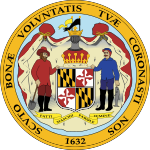| ||||||||||||||||||||||||||||||||||||||||
All 47 seats in the Maryland Senate 24 seats needed for a majority | ||||||||||||||||||||||||||||||||||||||||
|---|---|---|---|---|---|---|---|---|---|---|---|---|---|---|---|---|---|---|---|---|---|---|---|---|---|---|---|---|---|---|---|---|---|---|---|---|---|---|---|---|
| ||||||||||||||||||||||||||||||||||||||||
 Results: Democratic gain Republican gain Democratic hold Republican hold | ||||||||||||||||||||||||||||||||||||||||
| ||||||||||||||||||||||||||||||||||||||||
| Elections in Maryland |
|---|
 |
|
|
Elections for the Maryland Senate were held on November 6, 2018, with all 47 seats being contested. Republicans had initially hoped to break the Democrats' supermajority in the upper chamber by knocking off five incumbents, known as their "Drive for Five" plan.[1] Though they did make a net gain of one seat, they came short of their goal. Three seats switched hands: District 9 in Carroll and Howard Counties flipped from Republican to Democratic while District 38 in Somerset, Wicomico, and Worcester Counties and District 42 in Baltimore County both flipped from Democrats to Republicans.
The Maryland Senate has been in Democratic hands since the elections of 1900. Despite Governor Larry Hogan's success in his gubernatorial race at the top of the ticket, nobody expected Republicans to come close to recapturing the majority. In terms of popular vote, Maryland's Republican Senate candidates performed significantly worse than they previously had in 2014.
- ^ Kurtz, Josh (November 7, 2018). "GOP's 'Drive for Five' Stalls". Maryland Matters. Retrieved July 2, 2020.

